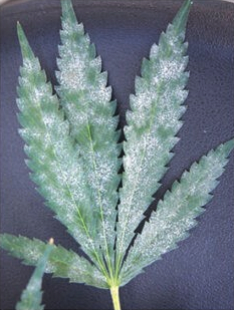
April 15, 2025
Introduction
Powdery mildew (PM) is one of the most common plant diseases that challenge cannabis growers worldwide. It can affect plant production in any type of growing environment including outdoor, greenhouse, and indoor settings. The fungi responsible for powdery mildew infection on both hemp and cannabis include Erysiphe, Leveillula, Podosphaeria and Golovinomyces to name a few [1, 2]. Golovinomyces was recently reported to be the main cause PM on cannabis in Canada [4]. These fungi are known as obligate parasites meaning, they require a living host to complete its life cycle. This cycle includes spores (conidia) which are produced in chains on stalks (conidiophores). Conidia give powdery mildew its signature “powdery” appearance and is easily dispersed throughout the environment by air currents. Asexual life cycles can be very short and start immediately with the landing of conidiophores on the plant surface facilitating a rapid spread [5, 6]. A full mycelial network is known to develop within 2 weeks post inoculation therefore completing the life cycle [3].
Once established, it can be extremely difficult to eradicate, therefore, prevention is key. Infections can limit the photosynthetic capacity of plants therefore reducing yield, reduce nutrient availability to the plant, and reduce cannabinoid production. It is rare for infections to kill the host plant however, contaminated flower/trim can fail visual inspections at testing labs. Due to strict cannabis compliance testing, the types of chemical options available for use are limited (see below). Robust cultural and physical practices must also be followed to prevent outbreaks leading to failed crops affecting the bottom line. Also, selecting strains that are known to be resistant to PM either through anecdotal in house observations or from trusted sources is key. In this discussion, we will review the most recent research on powdery mildew, prevention/control options, as well as the status of powdery mildew resistance breeding.
Environmental Factors
Unfortunately for growers PM can grow in a wide temperature and relative humidity (RH) range. In general, growth and disease pressure are highest when both temperature and humidity are high. Golovinomyces orontii (G. orontii), mentioned above, has been shown to germinate at temperatures as low as 50oF and as high as 86oF on cucumber plants [7]. While growth may be slowed at lower temperature, it can immediately accelerate again once temperatures are more favorable for growth. Studies have shown that at temperatures above 86oF disease pressure can be significantly reduced for various food crops [7-9]. This is, however, higher than what would be recommended for an indoor or greenhouse setting (Table 1). Conditions in the dry/curing rooms can also play a role in disease prevention. While longer, slightly higher RH conditions may be more conducive to preserving terpene content of the finished product, it may also be allowing for more mold and mildew growth.
Humidity ranges can vary wildly in which PM can develop. For example, the optimum RH range for PM development on tomato has been shown to be between 50-70% (range used in most cannabis environments) [9]. Growth was slowed but not completely ceased at humidities between 20-40% and humidities in the 80-90% were still favorable for spore germination. One area of the grow facility that may be the most susceptible to PM pressure is the propagation room. Many growers utilize domes for rooting cuttings in which the humidity levels can rise to saturation of the plant material. If PM pressure is low or non-existent on the mother plants this may not be an issue. However, if PM is present at any level, placing cuttings under a dome can easily lead to further disease development. In general, under heavy PM pressure, it is always recommended to lower the humidity.
For a detailed discussion about the cultural practices and chemical options available to help prevent powdery mildew infestations, see our previous review “Powdery Mildew: Control and Prevention”.
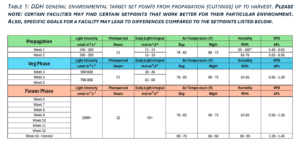
Future Breeding Efforts
Breeding efforts to establish PM resistant cannabis plants is well under way. Identification of resistant (R) genes and also susceptibility (S) genes are critical for the development of resistant lines [10]. Due to lack of funding for cannabis research, the underlying mechanisms for resistance are still not yet well understood (for review see [11]). As restrictions continue to ease at the federal level, future studies utilizing strains with known resistance to PM can be valuable tool in the process (Figure 2). One of the first known R-genes to be identified is known as PM1 [12]. This gene had all of the characteristics which define a typical resistant gene including conserved nucleotide-binding sites (NBS) and/or leucine-rich repeat (LRR) domains (also known as NLRs) [10, 12]. All this to say, certain strains have a greater ability to recognize a pathogen attack and mount an appropriate response. Further identification of more R genes will only benefit the cannabis industry as whole in the long run. Breeding efforts can take a long time to develop even after key genes have been identified. In the meantime, robust pest-management plans will be necessary to ensure disease free products.
Powdery Mildew Resistance Locus (PM2)
It has been about a year since we last discussed powdery mildew and the research efforts underway to identify potential markers associated with powdery mildew resistance (summarized above). Most recently, Seifi et al. (2025) have identified a novel powdery mildew resistance locus (PM2) within the cannabis genome through the use of next-gen sequencing and bioinformatic approaches [3]. In total, these researchers screened an impressive 510 different genotypes with observed differences in PM susceptibility (Figure 3).
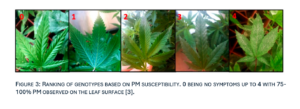
Based on these rankings, F1 populations were created and among those two in particular caught the attention of the research team. Resistant parents W03 and N88 were crossed with the susceptible cultivar AC and these lines were used to locate and identify the region associated with PM resistance (Figure 4). Also, based on the observed inheritance of the resistance trait (1:1), the authors indicated that PM resistance is controlled by a single dominant locus. Within this locus, the authors described 13 coding sequences (genes) that have known disease resistance functions in other plant species. These genes fell into three distinct categories. First, genes involved in hormonal regulation (salicylic acid signaling pathway in particular) . Second, genes involved in reactive oxygen species (ROS) production and finally, genes predicted to encode resistance genes based on gene homology to other plant species.
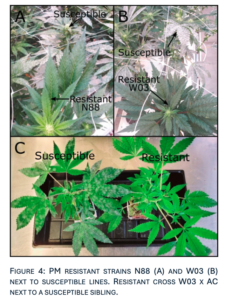
Another interesting study the authors performed was to investigate the mechanism by which the resistance populations seem to possess. Using a previously established method, detection of hydrogen peroxide (H2O2) is used as an indicator for a hypersensitive response (also associated with resistance) (Figure 5). Sensitive genotypes on the other hand do not “stain” indicating a lack of response when infected. Overall, these assays were much in line with what would be expected. High H2O2 accumulation was observed in resistant lines and the opposite was seen with susceptible lines. Also, ROS accumulation was observed within the epidermis and mesophyll cells of infected leaves.
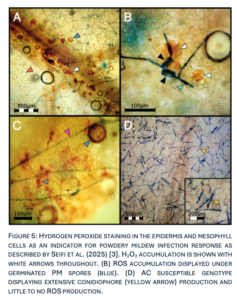
Conclusions
Powdery mildew can be a devastating disease for any type of growing environment, reducing yield and cannabinoid content. As new breeding programs develop more resistant cannabis lines, starting with common sense cultural practices and having tight environmental control in both a greenhouse and indoor setting are critical. When designing a new facility, having a clear understanding of the HVAC and dehumidification requirements are critical for successful operations. Retrofits may also be required for existing facilities if they are having continuous issues with PM temperature control. Chemical control options, while limited, also provide a way to prevent and control this disease.
Previously, PM1 was reported as the first resistant locus within the cannabis genome [12]. This study has now identified a second PM locus named PM2. The relationship between these two loci remains to be seen. However, research such as this represents a tremendous step forward in the development of breeding targets, or markers, that can be used to develop strains resistant to this devastating fungus.
References:
- Farinas, C. and F. Peduto Hand, First Report of Golovinomyces spadiceus Causing Powdery Mildew on Industrial Hemp (Cannabis sativa) in Ohio. Plant Disease, 2020. 104(10): p. 2727-2727.
- Punja, Z.K., First report of the powdery mildew pathogen of hops, Podosphaeria macularis, naturally infecting cannabis (Cannabis sativa L., marijuana) plants under field conditions. Canadian Journal of Plant Pathology, 2022. 44(2): p. 235-249.
- Seifi, S., et al., Mapping and characterization of a novel powdery mildew resistance locus (PM2) in Cannabis sativa L. Frontiers in Plant Science, 2025. 16: p. 1543229.
- Scott, C. and Z.K. Punja, Evaluation of disease management approaches for powdery mildew on Cannabis sativa L. (marijuana) plants. Canadian Journal of Plant Pathology, 2021. 43(3): p. 394-412.
- Kusch, S., et al., Long-term and rapid evolution in powdery mildew fungi. Molecular Ecology, 2024. 33(10): p. e16909.
- Hückelhoven, R. and R. Panstruga, Cell biology of the plant–powdery mildew interaction. Current Opinion in Plant Biology, 2011. 14(6): p. 738-746.
- Trecate, L., et al., Effect of temperature on infection and development of powdery mildew on cucumber. Plant Pathology, 2019. 68(6): p. 1165-1178.
- Uloth, M.B., M.P. You, and M.J. Barbetti, Plant age and ambient temperature: significant drivers for powdery mildew (Erysiphe cruciferarum) epidemics on oilseed rape (Brassica napus). Plant Pathology, 2018. 67(2): p. 445-456.
- Guzman-Plazola, R.A., R.M. Davis, and J.J. Marois, Effects of relative humidity and high temperature on spore germination and development of tomato powdery mildew (Leveillula taurica). Crop Protection, 2003. 22(10): p. 1157-1168.
- Sirangelo, T.M., Nlr-and mlo-based resistance mechanisms against powdery mildew in Cannabis sativa. Plants, 2023. 13(1): p. 105.
- Sirangelo, T.M., R.A. Ludlow, and N.D. Spadafora, Molecular Mechanisms Underlying Potential Pathogen Resistance in Cannabis sativa. Plants, 2023. 12(15): p. 2764.
- Mihalyov, P.D. and A.R. Garfinkel, Discovery and genetic mapping of PM1, a powdery mildew resistance gene in Cannabis sativa L. Frontiers in Agronomy, 2021. 3: p. 720215.




